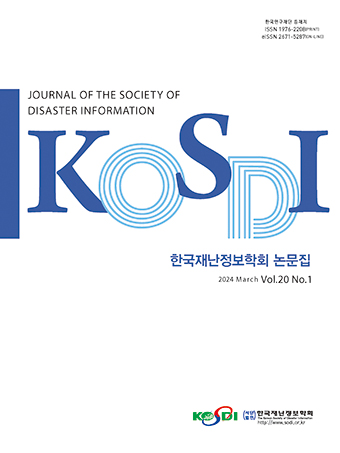Original Article
Abstract
References
Information
Purpose: The purpose of this study is suggested to improve upon current existing methods of ammonia chemical accident prevention and damage reduction. Method: Ammonia is one of the most common toxic substances that causes frequent chemical accidents. And it was selected as leakage materials according to statistics on chemical accident. Based on actual cases of chemical accidents, CARIS modeling was used to compare the damage impact range of Ammonia and HCl and Cl. Also, find out problems with the current systems. Result: As a result of find out the range of accident influence that spreads to the surroundings when an ammonia chemical accident, it was longer than the range of influence of hydrochloric acid and shorter than that of chlorine. In addition, it was found that when chemical accident by ammonia, hydrochloric acid, or chlorine, there are apartments and schools, which can have an effect. Conclusion: It is decided that it is necessary to determine whether or not chemical accident prevention management plans and statistical investigations are submitted for workplaces dealing with ammonia, and detailed guidelines and reviews are necessary. In addition, it is judged that it is necessary to establish a DB for ammonia handling plants, and it is considered that information sharing and joint inspection among related organizations should be pursued.
연구목적: 본 연구에서는 암모니아 화학사고 발생 시, 사고 피해 최소화와 사고예방을 위한 현 제도의 개선방안을 제시하고자 한다. 연구방법: 화학사고 발생통계자료를 바탕으로 빈번한 화학사고를 일으키는 대표적인 독성물질 중 하나인 암모니아를 누출물질로 선정하였다. 또한, 실제 암모니아 화학사고 발생 사례를 바탕으로 CARIS 모델링을 활용해 암모니아, 염산, 염소의 피해영향범위를 비교해보았으며, 현 제도의 문제점을 파악하였다. 연구결과: 암모니아 화학사고 발생 시 주위에 확산되는 영향범위를 산정한 결과 염산의 사고영향거리보다 더 길게 나타났으며 염소의 사고영향거리보다는 더 짧게 나타났다. 또한, 암모니아, 염산, 염소 사고 발생시 아파트, 학교 등의 민감수용체가 존재하고 있어 영향을 미칠 수 있는 것으로 나타났다. 결론: 암모니아를 취급하는 사업장에 대해서 화학사고예방관리계획서, 통계조사 등의 제출여부를 파악하는 것이 필요하다고 판단되며 구체적인 세부지침 및 검토가 필요하다고 사료된다. 또한, 암모니아 취급사업장의 DB 구축이 필요하다고 판단되며 관계기관들 간의 정보공유 및 합동점검 등을 지향하여야 한다고 사료된다.
- Chun, K.-S., Kim, S.-B., Park, C.-H., An, S.-Y. (2014). "A study on improvement of chemical accident response information systems." Korean Journal of Hazardous Materials." Korean Journal of Hazardous Materials, Vol. 2, No. 1, pp. 38-42.
- Kim, H.-S., Jeon, B.-H. (2017). "Development plan of accident scenario modeling based on seasonal weather conditions -Focus on chlorine leakage accident-." Journal of the Korea Academia-Industrial, Vol. 118, No. 10, pp. 733-738.
- Kim, J.-H., Jeong, C.-M., Kang, S.-M.,Yong, J.-W., Yoo, B.-Y., Seo, J.-M. (2017). "Comparison study for impact range of prediction models through case study about Gumi hydrogen fluoride accident." Korean Chemical Engineering Research, Vol. 55, No. 1, pp. 48-53.
- Kim, S.-B., Park, C.-H., Ahn, S.-Y., Kim, J.-M., Chun, K.-S., Noh, H.-R.,Seok, G.-S., Yoon, Y. (2013). "Study of the Intergrated management for business handling hazardous chemicals." Journal of Korean Society of Disaster Information, Vol. 9, No. 3, pp. 259-265.
- Korea Occupational Safety & Health Agency (2012). Technical Guidelines for Accident Damage Prediction Method.
- Lee, H.-S., Lee, T.-H., Park, K.-S., Kim, J.-G. (2019). "A study on the evaluation of effects of chemical accident toxicity using CARIS & ALOHA." Journal of the Korean Society for Environmental Technology, Vol. 20, No. 1, pp. 8-15. 10.26511/JKSET.20.1.2
- Meteorological Administration (2021). Statistical data from the Korea Meteorological Administration, https://data.kma.go.kr
- Ministry of Environment (2021). Chemical Substance Information System, https://icis.me.go.kr
- Ministry of Environment (2021), Chemicals Substance Control Act.
- Ministry of Environment (2014). 2012 Emergency Response Guidebook.
- Ministry of Trade, Industry and Energy (2021), High Pressure Gas Safety Control Act.
- Ryu, Y.-J., Lee, M.-K., Lee, S.-K. (2016). "Measures to prevent recurrence through the analysis of an explosion case at ammonia refrigeration facilities." Journal of the Korean Institute of Gas, Vol. 20, No. 3, pp. 38-45. 10.7842/kigas.2016.20.3.38
- Shin, C.-H., Lee, H.-S., Kim, T.-H.,Park, J.-H. (2016). "Analysis on chemical accident characteristics of facilities handling hydrochloric acid, fire science and engineering." Fire Science and Engineering, Vol. 30, No. 6, pp. 4-22.
- Yoo, B.-T. (2021). "A Study On Improvement Safety Management Chemical Accident Investigations." Journal of Korean Society of Disaster Information, Vol. 17, No. 3, pp. 403-414.
- Publisher :The Korean Society of Disaster Information
- Publisher(Ko) :한국재난정보학회
- Journal Title :Journal of the Society of Disaster Information
- Journal Title(Ko) :한국재난정보학회논문집
- Volume : 18
- No :2
- Pages :306-313
- DOI :https://doi.org/10.15683/kosdi.2022.6.30.306




 Journal of the Society of Disaster Information
Journal of the Society of Disaster Information







